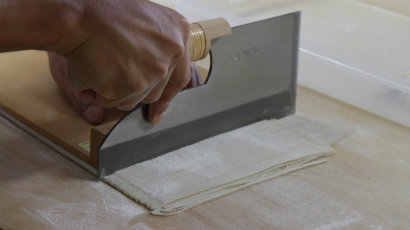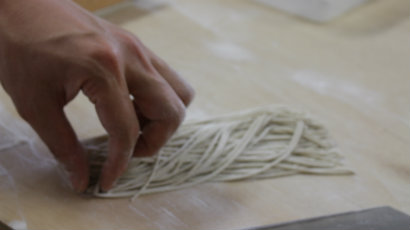Ichijyusansai / Nijyuyon sekki
Kanro no zen October 8th

Ishijyusansai and 24 Solar Terms…
Kanro・・・This is when the staple grains are coming to peak harvest. The air is clear and perfect to enjoy taking an excursion under the autumn skies.
Fall is in full swing. This menu uses so many fall foods! Many of the items listed are simple, making it easy to enjoy the true flavor of the ingredients. Just even thinking of food in the autumn can work up quite an appetite! Eating a lot (almost too much) happens a lot this time of year, but with such healthy food on the menu, at least you know its good for your body!
All recipes make servings for four.
Menu List
-
Steamed Akisake Salmon
 Shimeji mushrooms 1 Bunch
Shimeji mushrooms 1 Bunch
Enoki mushrooms 1 Bunch
Matsutake mushrooms 2 Mushrooms
Kabosu Citrus 1
Butter 4 cuts (45 grams)1. Cut potatoes into 5mm slices and boil.
2. Slice carrots and onions, cuts shimeji and enoki into bite size pieces.
3. Place carrots, onions on cooking paper, and then salmon on top. Place the potatoes, shimeji and enoki next to the salmon, wrap everything together in aluminum foil. Cook in an oven at 180℃ for 15 minutes.
4. Remove cooking paper and top with kabosu citrus and radish sprouts. Serve. -
Persimmons with shiraae (mashed tofu sauce)
 Persimmon 1 Persimmon
Persimmon 1 Persimmon
Momen tofu (firm tofu) 1/2 a block
Konnyaku 100g
Komatsuna (mustard spinach) 1 Bunch
Sake Enough to submerge the konnyaku
Soy sauce 3 Tablespoons
Mirin seasoning sake 3 Tablespoons
Salt One pinch of salt1. Cut the persimmon and konyaku into tansaku pieces (1cm x 3 cm), the komatsuna into 3cm pieces.
2. Blanch komatsuna, cool in ice water and strain.
3. Put konyaku into pot, add mirin, soy sauce, and enough sake to cover the konnyaku then boil down.
4. Strain Momen tofu, balance the ingredients so there will be 2 parts persimmon, one part konnyaku and one part komatsuna. add 2 or 3 drops of soy sauce to balance flavor and serve. -
Fried ginko beans
 Ginkgo beans 20 beans
Ginkgo beans 20 beans
Salt 2% (1/50th) of the amount of water used.1. Cut off half of the hard shell of the ginkgo beans.
2. Place beans in pot and add just enough water to cover the ginkgo beans and salt (2% of the amount of water), boil down.
3. When the water has evaporated and you begin to see the salt crystalize, toss the ginkgo beans cover with salt. Serve. Cooking tips We only remove half of the hard outer shell of the ginkgo because it makes it easy to eat and also, removing the whole shell would make it too salty. -
Miso soup with daikon, satoimo , and white onions
 Satoimo (Taro) Optimal amount
Satoimo (Taro) Optimal amount
Daikon Optimal amount
White onion Optimal amount
Miso 120g
Dashi 760ccplease see Shiratsugu Basics1. Cut satoimo and daikon into bite sized pieces and blanch. Cut white onions at an angle.
2. Add vegetables into miso soup. Heat and serve. -
Rice cooked with gobo burdock and hijiki
 Gobo (burdock) 1/2 Gobo
Gobo (burdock) 1/2 Gobo
Hijiki 1 handful
Konbu 5g
Sesame seeds Optimal amount
Rice 3 cups1. Make gobo sasagaki
2. For the rice, prepare 0.8% salt to the amount of water used (For 3 cups, add 5g of salt)
3. Add hijiki and gobo to the rice and cook. when finished cooking, place on plate, top with sesame seeds and serve.
Cooking tips
If the hijiki are dried hijiki, soak them before cooking them with rice. -
Preview of the next Ichijyusansai
 Next time we will prepare the Shimofuri no zen October 24th.
Next time we will prepare the Shimofuri no zen October 24th.
We are deep into fall. More great tastes of autumn coming your way. That sounds scrumptious! Hope you are looking forward to it as much as we are.







